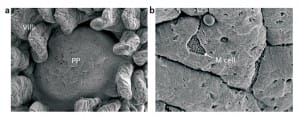 A dietary selection of more traditional fibre rich foods especially broccoli, appears to confer an immunological advantage to those patients suffering from the inflammatory bowel disease: Crohn’s. A paper published in the prestigious journal GUT recognised that Crohn’s is more common in industrialised nations than in those eating a more traditional diet. The study demonstrates that modern food ingredient called polysorbate 80 increases inflammation by altering the barrier integrity.[1]
A dietary selection of more traditional fibre rich foods especially broccoli, appears to confer an immunological advantage to those patients suffering from the inflammatory bowel disease: Crohn’s. A paper published in the prestigious journal GUT recognised that Crohn’s is more common in industrialised nations than in those eating a more traditional diet. The study demonstrates that modern food ingredient called polysorbate 80 increases inflammation by altering the barrier integrity.[1]
Polysorbate 80 is a nonionic surfactant and emulsifier derived from polyethoxylated sorbitan and oleic acid, and is often used in foods. Polysorbate 80 is a viscous, water-soluble yellow liquid.
Polysorbate 80 is used as an emulsifier in foods, particularly in ice cream. Here, polysorbate is added to up to 0.5% (v/v) concentration and makes the ice cream smoother and easier to handle, as well as increasing its resistance to melting. Polysorbate 80 is used as an emulsifier in the manufacture of medications for parenteral administration, most notably in the popular anti-arrhythmic amiodarone. It is also part of the adjuvant used in some European and Canadian influenza vaccines.

In terms of the physiology the lesions found in the gut afflicted with Crohn’s tends to lie over the Peyers patches and colonic lymphoid follicles where bacterial invasion across the membrane occurs via the specialised microfold cells or M cells.
E coli translocation across M-cells increased 15.8-fold with isolates of patients with Crohn’s disease vs 6.7-fold for control isolates. In contrast, plantain and broccoli non starch polysaccharide markedly reduced E coli translocation across M-cells at 5 mg/mL (45.3% -82.6% inhibition; P < .01), whereas apple and leek non starch polysaccharide had no significant effect.
The widely used emulsifier, polysorbate 80, at a concentration of 0.01% vol/vol, increased E coli translocation through Caco2-cl1 monolayers 59-fold (P < .05) and, when given at higher concentrations, increased translocation across M-cells. Likewise, E coli translocation across human Peyer’s patches was reduced 45%±7% by soluble plantain nonstarch polysaccharide (5 mg/mL) and was increased 2-fold by polysorbate 80 (0.1% vol/vol).
According to the researchers, dietary fibre may act by blocking the interaction between intestinal bacteria and the epithelium, whereas polysorbate 80 has been shown to integrate within cell membranes, resulting in a change of membrane microviscosity.
This may in part explain an earlier finding of increased anaphylactic reactivity. According to Annals of Allergy, Asthma and Immunology,[2] the authors stated
“it is of current relevance as a ‘hidden’ inductor of anaphylactoid reactions”, and “Polysorbate 80 was identified as the causative agent for the anaphylactoid reaction of nonimmunologic origin in the patient.
Conclusions: Polysorbate 80 is a ubiquitously used solubilising agent that can cause severe non immunologic anaphylactoid reactions.”
Comment
This study demonstrates that in patients with a unique disruption of their mucosal immune tissues, the addition of one common food agent may activate an increase in inflammatory responses due the the changes in the micro architecture resulting in greater physical symptoms. From a clinical perspective the foods that contain polyscorbate are great in number and when managing your IBD patient you would be advised to not simply increase the recommended intake of broccoli but also reduce polysorbate containing medicines and foods.
References
[1] Roberts CL, Keita AV, Duncan SH, O’Kennedy N, Söderholm JD, Rhodes JM, Campbell BJ.Translocation of Crohn’s disease Escherichia coli across M-cells: contrasting effects of soluble plant fibres and emulsifiers. Gut. 2010 Oct;59(10):1331-9. Epub 2010 Sep 2. View Full Paper
[2] Coors EA, Seybold H, Merk HF, Mahler V. Polysorbate 80 in medical products and nonimmunologic anaphylactoid reactions. Ann Allergy Asthma Immunol. 2005 Dec;95(6):593-9. View Abstract





